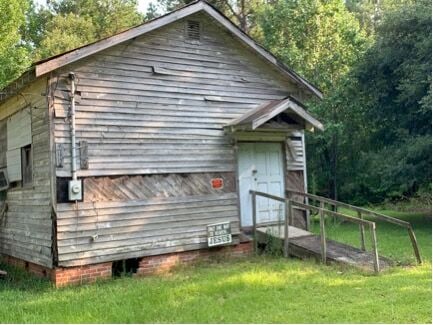
The Goins School, built in 1935 by the Works Progress Administration.
Photo Provided
Local Native American Descendants Reorganize
The Greeleyville Band of Black River Indians, formerly known as the Goins Band of Chicora, recently reorganized, officially electing their first chief and tribal council after having previously been considered as part of the Chicora Indian Tribe and later the ECSIUT. The Black River Indians, whose membership is comprised of individuals that trace their heritage back to two Native American brothers, John and Madrey Goins, are seeking to reclaim and preserve their ancestral culture before it’s too late.

Chief William Goins holding a dahápi, or traditional feather standard, next to a newly erected sign at John Goins Cemetery.
Photo Provided
Chief William Goins and the tribal council are currently undertaking efforts to restore John Goins Cemetery and the Goins School, a Works Progress Administration era schoolhouse for Native Americans where members of the Goins Indian Community received their education prior to desegregation. The community’s history in Williamsburg stretches back well over a century, having originated as an offshoot of the Privateer Indians of Sumter County around the time of the Civil War. The Privateer Indian Community, later referred to as the Smiling Indian Community, was a multi-tribal entity comprised of mixed Catawba, Hatteras, and other people descended from remnant coastal tribes, that ceased to exist independently around the turn of the twentieth century. Descendants of the Goins Indian Community, however, have persisted and maintained their Native American identities, despite facing decades of discrimination during the twentieth century.
The community has been written about in books and was listed on maps as a major Native American community in South Carolina into the 2000s. It was additionally subject to study by prominent ethnohistorian, Wes Taukchiray, beginning in the seventies. Today, his report is housed by the Center for the Study of Man at the Smithsonian in Washington, D.C.
Ancestors of the Band have lived along the Yenee dating back to at least the eighteenth century with some lines likely tracing back thousands of years and subsequently to the legendary kingdom of Chicora. Some of the ancestors of the Band later fought alongside the likes of General Thomas Sumter and Francis Marion for independence from Great Britain during the Revolutionary War. Chief Goins, who is a direct descendant of John Goins and the patriarchs of the Privateer Indian Community, says he hopes to help reinstate the traditional Catawba language that his ancestors spoke into the late nineteenth century, as well as promote the culture for a new generation. Elected councilman, Zack Cook, a student at the University of South Carolina School of Law, said, “American Indians are the only group required to prove their identities, but the truth is that our people have always been here and some have wanted us to disappear for generations. They would say, you’re too dark, you’re too light, you don’t look like those people on TV, so you’re not real Indians, but our roots, they deeply entwine with these lands, and these lands know us, as they’ve known our ancestors, and will continue to know our progeny”.
The Band’s enrollment is presently open to those who can prove they are lineally descended from either of the original progenitors of the Goins Indian Community in Greeleyville. Descendants of the community stretch along the course of the Black River, in the counties of Sumter, Clarendon, Williamsburg, and Georgetown. Related core surnames include Braxton, Mitchum, Barrineau, and Ard, among others.
The group hopes to educate the general public of the history and lifeways of Native Americans in the area, as well as take on many projects to preserve their unique heritage, including erecting historical markers, restoring cemeteries, and placing stones on unmarked graves.








